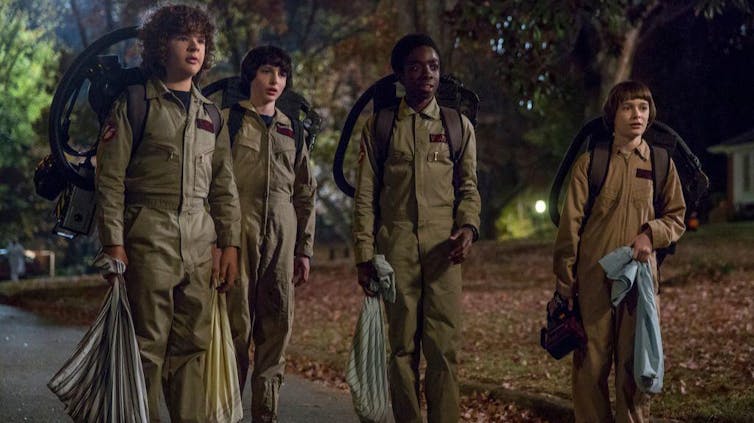Stranger Things 2 is darker and weirder, tempered with grief
- Written by Mark Steven, Research Fellow, UNSW
This week, in the run-up to Halloween, Netflix released season two of Stranger Things, a sequel to last year’s runaway success. Like the previous season, Stranger Things 2 enjoys a visual style crafted from period-specific horror films first released in the early and mid-1980s. Part of the joy is in collecting these citations and echoes.
The Evil Dead (1981), A Nightmare on Elm Street (1984), and Firestarter (1984) are all very much present for this season, shaping the look and feel no less than explicit content. So too is the greatest of all seasonally appropriate films, Halloween III: Season of the Witch (1982), about which it is impossible not to think upon sights of rotted, worm-infested pumpkins.
Though I want to avoid dropping too many spoilers, there are some welcome differences at the level of narrative content: an expanded universe, new characters, and more Dustin (a charming Goonies throwback from the central teen gang) all make for seriously addictive viewing. There are new mysteries to unravel and new threats to vanquish, as well as a healthy dose of urban revolt as manifest through telekinetic rage.
Further reading: Nostalgia, VHS and Stranger Things’ homage to 80s horror
But it’s also a much darker season. The previous year’s events have metastasized into psychic scars. The mood, this time around, is tempered by grief and trauma.
New horror
The most significant change, however, is in the type of horror now menacing the township of Hawkins. While the previous season established a sci-fi shtick worthy of Ridley Scott and John Carpenter, Stranger Things 2 modulates away from that and into a related type of horror that is, perhaps, more literary than cinematic.
 The gang in Stranger Things 2, in their Ghostbusters Halloween tribute.
Netflix
The gang in Stranger Things 2, in their Ghostbusters Halloween tribute.
Netflix
This centres on a figure that features in trailers, on posters, and which appears in the very first episode. A gargantuan being made up of coiling smoke and darkness, a towering force all tenebrous and sublime, a strange thing that is both arachnoid and cephalopod and so thoroughly anterior to anything even remotely human – whatever it is, it looms over everything in a storm of red, and it wants to kill.
The struggle to find a meaningful noun for this entity – which the Stranger Things wiki describes as both Shadow Monster and Mind Flayer – is revealing of its textual origin. This is the kind of “indescribable” monstrosity familiar to many from the weird fiction of H. P. Lovecraft.
The creators of Stranger Things have acknowledged precisely this influence on the new season: “There’s an H.P. Lovecraft sort of approach,” confirms Matt Duffer, “this inter-dimensional being that is sort of beyond human comprehension. We purposely don’t want to go too much into what it is or what it wants.”
Moreover, it is in a Lovecraft story, The Shadow Out of Time (1935), that we find an origin for the series’ title:
As I have said, it was not immediately that these wild visions began to hold their terrifying quality. Certainly, many persons have dreamed intrinsically stranger things – things compounded of unrelated scraps of daily life, pictures, and reading, and arranged in fantastically novel forms by the unchecked caprices of sleep. For some time I accepted the visions as natural, even though I had never before been an extravagant dreamer.
Visually, however, the inter-dimensional being that haunts Stranger Things 2 owes just as much to what might be the single most effective adaptation of Lovecraft onto screen.
The 2015 videogame, Bloodborne, was marketed as traditional gothic horror. Its first acts are set in an isolated city, Yarnham, gone to hell in a lycanthropic scourge of beasts. It is only later revealed that the Yarnhamites had been worshiping an ancient, eldritch race whose reality overlays our own. In other words, the Great Ones had been there all along, we just lacked the insight to see them.
That’s the point of both Lovecraft and Stranger Things. Horror is everywhere and immanent but it’s not necessarily visible. And, once you glimpse it – in Bloodborne, clinging to the roof of a heretofore familiar chapel – it can’t be unseen. Lovecraft’s defining affect is not so much fear or revulsion as it is a kind of haunted fascination. We can say much the same for Stranger Things.
 The monster revealed in Bloodborne.
Bloodborne
The monster revealed in Bloodborne.
Bloodborne
The horror of capitalism
How do we make sense of this apparent commitment to Lovecraftian horror?
The first season of Stranger Things was an affirmation of collective identities, the bonds of childhood friendship that cut across race, class, and gender. It is, I have suggested, a visual narrative whose nostalgia is not just for 1980s culture, but also a profound longing for the old conflict between communal vitality and capitalist alienation.
This longing is informed by history, and especially by the antagonism between American capitalism and Soviet communism. Stranger Things 2 retains this historical backdrop, with its endemic fear of communists, and supplements it with a tour of urban blight in the American Midwest. Chicago – in which a late side-plot episode takes place – is all roving gangs and trashcan fires.
Horror, in Stranger Things, emanates from the underside of North America in the 1980s. The unleashing of that monster, whatever it might be, results from the repressive gestures taken by capitalism to secure victory over its opposition, both local and global.
It was, of course, during the 1980s that Ronald Reagan dismantled unions and deregulated the market, therefore obliterating any sort of collective identity that might sustain revolutionary unity and pose a threat to American capitalism. This obliteration is what Stranger Things pits its heroes against – and that is why Stranger Things 2 is required viewing for socialists this Halloween.
Authors: Mark Steven, Research Fellow, UNSW
Read more http://theconversation.com/stranger-things-2-is-darker-and-weirder-tempered-with-grief-86614




